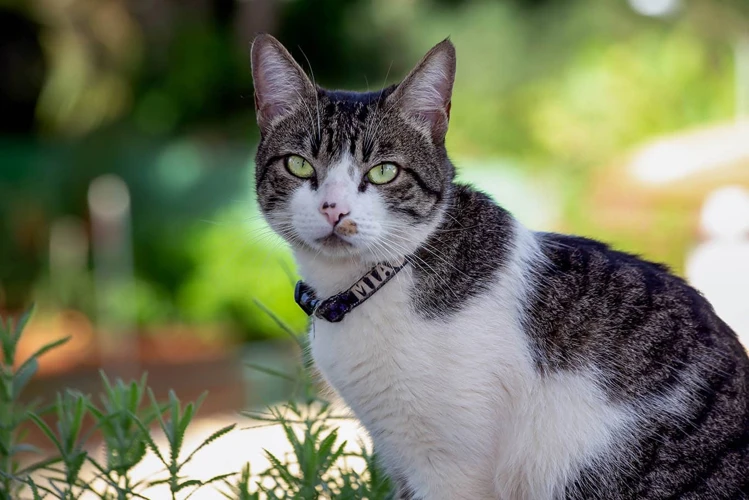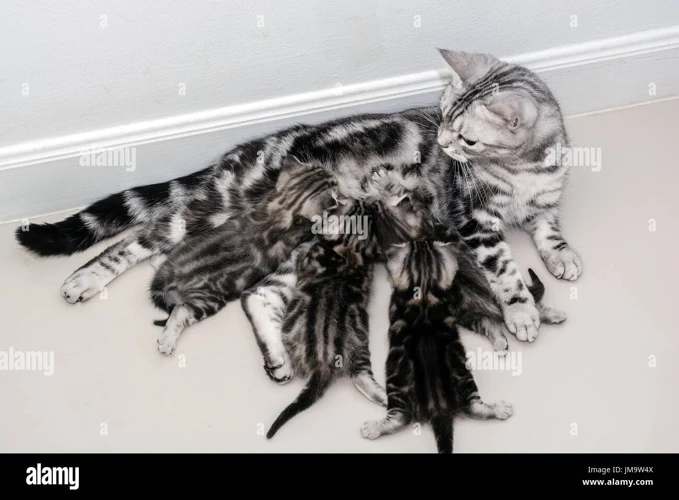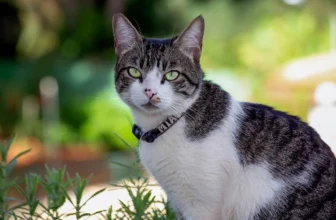Welcoming a new American Wirehair kitten into your home can be an exciting and overwhelming experience, especially when it comes to their nutrition. As a devoted pet owner, you want to ensure that your furry friend receives the very best care, starting with their diet. But where do you begin? With so many different kitten foods, brands, and feeding schedules out there, it can be hard to know what is best for your kitten. Fortunately, with a little bit of knowledge and the right approach, providing proper nutrition to your American Wirehair kitten can be straightforward and stress-free. So let’s dive into the basics of feeding your newborn American Wirehair, from understanding their nutritional needs to transitioning them to adult food.
Understanding Your American Wirehair Kitten’s Nutritional Needs

Understanding your American Wirehair kitten’s nutritional needs is crucial to their growth and development. As a pet owner, it’s your responsibility to provide your furry friend with the proper nutrients required for a healthy and happy life. Feeding your kitten the right food in the correct amounts will also impact their immune system, dental health, and overall well-being. This article will provide valuable insights into American Wirehair kitten nutrition, so you can confidently provide the best care for your new feline friend. For more information on other aspects of caring for your newborn American Wirehair kitten, check out our article on newborn Wirehair care tips.
Why Proper Nutrition Is So Important for Kittens
Proper nutrition is essential for kittens to grow into healthy adult cats. During the first few weeks of life, newborn American Wirehair kittens rely solely on their mother’s milk for nutrients. As they age and start to wean, it’s important to introduce them to a balanced diet that meets their nutritional needs.
One of the primary reasons why proper nutrition is crucial for kittens is to support their growth and development. Kittenhood is a critical stage in a cat’s life, and feeding your kitten a well-rounded diet can help ensure that they reach their full potential. Proper nutrition also helps support your kitten’s immune system, which is still developing and may be vulnerable to infections and illnesses.
It’s important to note that different breeds of cats may have different nutritional needs. American Wirehair kittens, for example, may have different requirements for protein, fat, and other nutrients compared to other breeds. Understanding the nutritional needs of your Wirehair kitten is essential for ensuring that they grow up healthy and strong.
In addition to supporting growth and development and strengthening the immune system, proper nutrition can also help prevent certain health problems later on in life. Feeding your kitten a high-quality diet can reduce the risk of obesity, dental problems, and digestive issues.
Proper nutrition also plays a role in your kitten’s overall wellbeing and behavior. A well-fed kitten is likely to be more active, curious, and playful. On the other hand, a kitten who is not getting all of the nutrients they need may experience lethargy, weakness, and other health problems that can affect their personality and behavior.
Providing your American Wirehair kitten with proper nutrition is essential for their lifelong health and wellbeing. By understanding their nutritional needs and choosing high-quality foods that meet those needs, you can help give your kitten the best possible start in life.
For more information on taking care of your American Wirehair kitten, check out our article on wirehair litter health or our guide to caring for newborn wirehairs.
How to Choose a High-Quality Kitten Food
Choosing a high-quality kitten food is crucial for the health and well-being of your American Wirehair kitten. Here are some factors to consider when selecting a kitten food:
| Factor | Description |
|---|---|
| Premium Ingredients | Look for kitten food with high-quality ingredients, such as real meat (e.g. chicken, turkey, or fish), whole grains, and vegetables. Avoid kitten food that contains by-products or artificial preservatives, colors, or flavors. |
| Protein and Fat Content | Kittens need a protein-rich diet to support their growth and development. Look for kitten food that has at least 30% protein and 12% fat. |
| Complete and Balanced Nutrition | Make sure the kitten food you choose is labeled as “complete and balanced,” which means it contains all the nutrients your kitten needs in the right proportions. |
| Age-Specific Formulas | Choose kitten food that is formulated specifically for your kitten’s age. This ensures that your kitten is getting the right balance of nutrients for their developmental stage. |
| Brand Reputation | Do some research on the brand of kitten food you are considering. Look for a company with a good reputation for producing high-quality, safe, and nutritious pet food. |
By taking the time to choose a high-quality kitten food, you can help ensure that your American Wirehair kitten grows up healthy and strong. It’s important to keep in mind that every kitten is unique, so you may need to experiment with different brands and formulas to find the one that works best for your kitten’s needs.
If you would like to learn more about preparing for your new American Wirehair kitten, check out our guide on how to prepare your home for wirehair kittens.
What to Look for in Nutrition Labels
Nutrition labels can be overwhelming, but they are an essential tool for choosing the right food for your American Wirehair kitten. When looking at a label, there are a few key things to focus on:
- Protein: Look for a food that has a high protein content, since kittens need lots of protein to support their growth and development. A minimum of 30% protein is recommended.
- Fat: Kitten food should also be high in fat, since fats provide energy and support the absorption of certain vitamins. Look for a food with at least 20% fat.
- Carbohydrates: While carbohydrates are not essential, they can provide a source of energy. Look for a food with a moderate carbohydrate content, ideally around 10-15%.
- Vitamins and minerals: Check that the food provides a balance of essential vitamins and minerals to support your kitten’s overall health and wellbeing.
- Avoid fillers: Avoid foods that contain fillers like corn, wheat, or soy, as these provide little nutritional value and can trigger allergies in some kittens.
It’s also important to pay attention to the ingredient list. Ingredients are listed in order of weight, so look for a food that has a high-quality protein (like chicken or fish) listed as the first ingredient. Keep an eye out for any artificial colors, flavors, or preservatives, since these don’t provide any nutritional benefits and can be harmful to your kitten’s health.
By paying close attention to nutrition labels and ingredient lists, you can ensure that your American Wirehair kitten is getting all the nutrients they need to grow into a healthy adult cat. And for more tips on caring for your new kitten, be sure to check out our article on the 5 essentials for your Wirehair breeding kit or our guide to Wirehair vet visit tips.
Feeding Your Newborn American Wirehair Kitten

Welcoming your new American Wirehair kitten into your home is an exciting time for both of you. As a new kitten parent, you may be wondering how to properly feed your furry friend. As a newborn, your kitten will have specific nutritional needs that require attention to ensure their optimal health. Proper feeding is vital to your kitten’s growth and development during this stage, and it’s important to know what and when to feed them to keep them healthy and happy. Let’s dive into the essential information you need to know about feeding your newborn American Wirehair kitten. Before we do, make sure you check out these articles, which can provide additional information on socialization, stages and vaccination of your kitten: happy-wirehair-kittens-socialization, understanding-wirehair-kitten-stages, and wirehair-kitten-vaccination-deworming.
What and How Much to Feed Your Kitten
As a newborn American Wirehair kitten owner, you may be wondering what and how much to feed your new furry friend. It’s important to understand that kittens have unique nutritional needs during this stage of their lives and that proper nutrition is crucial for their growth and development.
What to Feed Your Kitten
When it comes to feeding your newborn American Wirehair kitten, it’s recommended to provide them with a high-quality kitten food that is specially formulated for their nutritional needs. Look for a kitten food that is made from high-quality protein sources, such as chicken or turkey, as well as other essential nutrients like calcium, phosphorus, and Vitamin D.
It’s also important to avoid feeding your kitten human food, as it can upset their stomach and potentially be harmful to their health.
How Much to Feed Your Kitten
The amount of food your kitten needs will depend on their age, size, and weight. In general, it’s recommended to feed your kitten three to four small meals a day until they are about six months old.
To determine how much to feed your kitten, you can refer to the feeding guidelines on the kitten food packaging. These guidelines will provide you with recommended serving sizes based on your kitten’s weight and age.
It’s important not to overfeed your kitten, as this can lead to obesity and other health issues later in life. Similarly, underfeeding your kitten can also lead to health problems, such as malnourishment and stunted growth.
Feeding Schedule for Your Kitten
Establishing a feeding schedule for your kitten is also an important aspect of their overall nutrition. Try to feed your kitten at the same times each day to help them establish a routine.
It’s also important to provide your kitten with fresh, clean water at all times. As their activity levels increase, they will likely drink more water to stay hydrated.
By understanding what and how much to feed your newborn American Wirehair kitten, you can help ensure that they receive the proper nutrition they need to grow and develop into healthy adult cats.
When to Feed Your Kitten
One of the most important aspects of feeding your American Wirehair kitten is determining when and how often to feed them. While adult cats typically only need to be fed once or twice per day, kittens require more frequent meals to support their rapid growth and development.
Here are some key factors to consider when determining when to feed your kitten:
- Age: Younger kittens will need to be fed more frequently, often every two to three hours. As they get older, you can gradually decrease the frequency of feedings.
- Weight: Your kitten’s weight can also impact how often they need to be fed. A larger kitten may be able to go longer between feedings than a smaller one.
- Activity level: Kittens who are particularly active may need to be fed more often than those who are more sedentary.
- Health concerns: If your kitten has any health issues, such as hypoglycemia or a digestive disorder, they may require more frequent feedings to maintain their health.
It’s also important to establish a feeding routine that works for both you and your kitten. Consistency is key when it comes to feeding, so try to establish set meal times and stick to them as much as possible.
While it may be tempting to free feed your kitten (leaving food out all day for them to graze on), this can lead to overeating and obesity. Instead, measure out your kitten’s portions and feed them at designated times throughout the day. This will not only help prevent overeating, but also make it easier for you to monitor your kitten’s intake and ensure they are receiving adequate nutrition.
Remember, feeding your American Wirehair kitten is a crucial aspect of their overall health and wellbeing. By following these guidelines and paying close attention to their nutritional needs, you can help ensure they grow into healthy, happy adult cats.
Other Factors to Consider
As you begin to feed your new American Wirehair kitten, there are several other factors to consider besides just the type and amount of food. Water is essential for your kitten’s overall health, and they should have access to clean water at all times. Make sure to change their water daily and clean their bowl regularly.
Feeding Schedule is also important to consider. Kittens need to eat frequently to support their growth and development. Newborn kittens should be fed every 2-3 hours, while slightly older kittens can typically go 4-6 hours between feedings. As your kitten grows, you can gradually decrease the number of feedings per day.
Food Temperature is another factor to consider. Kittens have sensitive stomachs, and their food should be served at room temperature. Cold food can upset their stomach, while hot food can burn their mouth or throat. Always test the food’s temperature before feeding it to your kitten.
Treats like human food or commercial cat treats should be given in moderation and not as a substitute for their regular diet. Overfeeding treats can lead to obesity and other health problems. If you want to give your kitten a treat, choose a small piece of cooked meat or a specially made kitten treat.
Food Storage is also crucial for your kitten’s health. Opened cans or bags of dry food should be stored in a cool, dry place with the lid tightly closed. Avoid storing food in a damp or humid area to prevent the growth of harmful bacteria. Also, make sure to check the expiration date on the food before feeding it to your kitten.
Here’s a summary of the other factors to consider as you feed your American Wirehair kitten:
| Factors to Consider | Importance |
|---|---|
| Water | Essential |
| Feeding Schedule | Important |
| Food Temperature | Crucial |
| Treats | Moderation |
| Food Storage | Crucial |
By taking these other factors into consideration, you can help ensure that your American Wirehair kitten receives the proper nutrition, stays hydrated, and grows up to be a healthy adult cat.
Transitioning Your Kitten to Adult Food
As your American Wirehair kitten grows, their nutritional needs will change. At some point, you will need to transition them from kitten food to adult cat food. This can be a confusing and challenging process, but with the right information and approach, you can ensure a smooth and successful transition. In this section, we’ll delve into the details of how and when to make the switch, as well as what to look for in adult cat food. So, if you’re wondering how to navigate the transition from kitten to adult food, keep reading for some valuable tips and insights.
When to Start Transitioning Your Kitten
Transitioning your American Wirehair kitten from a kitten diet to an adult diet is an important process that should be done with care. You should start the transition when your kitten is around 10-12 months old. It’s important to pay attention to your kitten’s weight and development before starting the transition. If your kitten is underweight or has health issues, you may want to wait a bit longer before transitioning.
Before switching to adult food, make sure your kitten is eating well and has a good appetite. It’s also important to consider the type of food your kitten is currently eating. If your kitten is eating wet food, you’ll want to start by switching to a high-quality, grain-free dry food. If your kitten is already eating dry food, you can start by gradually mixing in the adult food.
It’s important to take the transition slowly to avoid digestive upset. Start by mixing a small amount of adult food with your kitten’s current food. Gradually increase the amount of adult food each day and decrease the amount of kitten food. This gradual transition should take around 2-3 weeks.
When choosing an adult cat food, look for a high-quality, grain-free option with a protein source as the first ingredient. American Wirehair cats have a tendency to gain weight, so choosing a food formulated for weight management or limiting portions can be helpful. It’s also important to make sure the food provides all the necessary nutrients for your cat’s health and development.
By following these steps and taking your time with the transition, you can help ensure that your American Wirehair cat transitions smoothly to their adult diet and maintains a healthy weight and lifestyle.
How to Transition Your Kitten to Adult Food
Transitioning your kitten to adult food is a crucial process that needs to be executed with care. Abruptly changing your kitten’s diet can lead to digestive issues and nutritional imbalances. It is essential to follow a few steps to successfully transition your kitten to an adult diet.
Gradual Transition: The best way to transition your kitten to adult food is through a gradual process. You can start by mixing a small amount of adult food into your kitten’s existing food. Over several days, gradually increase the amount of adult food and decrease the kitten food. This approach will enable your kitten’s digestive system to adapt to the new food slowly.
Changing the Quantity: When you transition your kitten to adult food, you also need to change the amount of food you provide. Adult cats generally require fewer calories than growing kittens, so it’s important to adjust the quantity of food they receive accordingly. Check the recommended serving sizes on the cat food packaging and adjust the amount you feed your cat based on their age, weight, and activity level.
Monitor Your Kitten: Keep a close eye on your kitten during the transition process. Keep track of their weight and observe their behavior to identify any potential issues. If your kitten develops digestive issues or other health problems, consult with your veterinarian immediately.
Choose a High-Quality Adult Cat Food: It’s important to choose a high-quality adult cat food that meets your cat’s nutritional needs. Look for food that contains high-quality protein, essential vitamins, and minerals, and avoid food that contains fillers, artificial preservatives, and other harmful ingredients.
Stick to a Feeding Schedule: As with kittens, adult cats require a consistent feeding schedule. Stick to a regular feeding routine and avoid feeding your cat table scraps or human food. Additionally, always ensure that fresh water is available to your cat at all times.
Transitioning your kitten to adult food requires a gradual transition, adjusting the quantity, monitoring your kitten, choosing a high-quality adult cat food, and sticking to a feeding schedule. Follow these steps, and with a little patience, your kitten will be happily enjoying their new adult diet without any health issues.
What to Look for in Adult Cat Food
When transitioning your American Wirehair kitten to adult food, it’s important to choose a high-quality cat food that meets their specific nutritional needs. Here are some key factors to consider when selecting an adult cat food:
- Protein: Look for adult cat foods that have high-quality sources of protein, such as chicken, turkey, or fish. The protein content should make up at least 30% of the food.
- Fat: Your American Wirehair needs healthy fats for energy and to help maintain a healthy coat. The fat content in their adult food should be between 10-20%.
- Carbohydrates: While cats don’t need as many carbohydrates in their diet as humans or dogs, they still require some for energy. Look for cat foods that have a moderate amount of carbohydrates, such as brown rice or sweet potatoes.
- Vitamins and Minerals: Your American Wirehair needs a balance of essential vitamins and minerals to stay healthy. Look for cat foods that have added vitamins and minerals, or that use whole foods as sources of these nutrients.
- No Fillers or Artificial Preservatives: Avoid cat foods that contain fillers such as corn or wheat, as these ingredients offer little nutritional value and can cause digestive issues. Additionally, look for cat foods that don’t include artificial preservatives, as these can be harmful to your cat’s health.
- Certified by AAFCO: The Association of American Feed Control Officials (AAFCO) sets nutritional standards for cat food. Look for cat foods that meet their guidelines for complete and balanced nutrition.
By keeping these factors in mind, you can choose an adult cat food that will provide your American Wirehair with the essential nutrients they need to maintain optimal health and wellbeing.
Conclusion
Wrapping Up: A Healthy Start for Your American Wirehair Kitten
Feeding your newborn American Wirehair kitten can be both exciting and challenging. But with the right knowledge and guidance, you can ensure your kitten gets the best possible start in life.
Remember, proper nutrition is crucial during the first few months of your kitten’s life, as it supports their growth and development. Choosing a high-quality kitten food that meets their nutritional needs is essential. Pay attention to the ingredients listed on the label and select a brand that includes high-quality protein sources, healthy fats, and essential vitamins and minerals.
When feeding your kitten, start with small, frequent meals to support their small digestive system. As your kitten grows and develops, gradually increase meal sizes and reduce the number of feedings. Make sure to provide fresh, clean water at all times.
When it’s time to transition your kitten to adult food, do so slowly to avoid digestive upset. Look for adult cat food that contains all the necessary nutrients your American Wirehair cat needs to maintain a healthy weight and support their overall health.
In conclusion, feeding your American Wirehair kitten requires attention, patience, and care. By following the tips and guidelines laid out in this article, you can ensure your kitten gets off to the healthiest start possible and enjoys a long, happy life with you.
Frequently Asked Questions
How often should I feed my newborn American Wirehair kitten?
Newborn kittens should be fed every 2-3 hours, including during the night. As they grow older, you can gradually decrease the frequency of feeding.
What type of food should I feed my American Wirehair kitten?
You should choose a high-quality kitten food that is specially formulated for kittens and meets their nutritional needs. Look for a food that contains high levels of protein, fat, and essential nutrients like vitamins and minerals.
How much should I feed my American Wirehair kitten?
The exact amount of food your kitten needs will depend on their age, weight, and activity level. Follow the guidelines on the food label, but also observe your kitten’s body condition and adjust the amount of food accordingly.
Should I give my American Wirehair kitten wet or dry food?
Both wet and dry food can be appropriate for kittens. However, wet food can provide more moisture and may be easier for some kittens to digest. Consult with your veterinarian to determine the best option for your kitten.
When can I start transitioning my kitten to adult food?
Kittens can usually be transitioned to adult food after they reach 12 months of age. However, you should always consult with your veterinarian before making any changes to your kitten’s diet.
How long does the transition to adult food take?
The transition period should be gradual and last for about a week. You can start by introducing a small amount of adult food mixed in with your kitten’s current food and gradually increasing the amount of adult food each day.
What should I look for in adult cat food?
Adult cat food should be formulated specifically for adult cats and contain a balanced mix of protein, fat, and essential nutrients. Look for high-quality ingredients and avoid fillers like wheat, corn, and soy.
Can I give my kitten human food?
While it may be tempting to feed your kitten table scraps or human food, it is not recommended. Human food is often too high in salt, fat, and other ingredients that can be harmful to your kitten’s health.
Why is proper nutrition so important for kittens?
Kittens require a balanced and nutrient-rich diet to support their growth and development. Proper nutrition helps ensure that they develop strong bones, muscles, and a healthy immune system.
What should I do if my kitten is not eating?
A lack of appetite can be a sign of illness or stress in kittens, so it is important to consult with your veterinarian if your kitten is not eating. They can provide advice on how to encourage your kitten to eat and determine if there is an underlying health issue that needs to be addressed.







